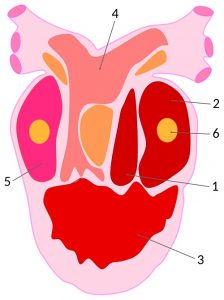Many animals have a closed circulatory system, where the blood is maintained in vessels and pumped by a heart. Some organisms, such as many mollusks, have an open system, where the blood washes over and around tissues. Animals with a closed circulatory system tend to have higher blood pressure. The blood is also able to travel further than in an open system. These animals may have a one-, two-, three-, or four-chambered heart.
| Frog | Fish | Earthworm | |
| Open or closed circulatory system | Closed | Closed | Closed |
| Number of circuits for circulation | Three | One | One |
| Chambers in the heart | Three | Two | One |
| Number of hearts in body | One | One | Five |
Frog Circulation
Frogs are amphibians and have a closed circulatory system. Unless there is an abnormal mutation present, frogs only have one heart to pump blood throughout the body.
A frog has a three-chambered heart. The chambers include two atria and a ventricle. The right atrium receives deoxygenated blood from the veins. Oxygenated and deoxygenated blood have a tendency to mix within the ventricle that is responsible for pumping blood. The left atrium receives oxygenated blood from both the lungs and the skin.
Frogs have three circuits for their circulation, unlike humans who only have two. Like humans, however, frogs have a systemic circuit, which pumps oxygenated blood throughout the body. The pulmonary circuit moves blood to the lungs to pick up oxygen. Frogs also have a pulmocutaneous circuit, where deoxygenated blood is transported to the skin to pick up oxygen and undergo gas exchange.
The below image shows a diagram of a frog’s heart with its three chambers.
Fish Circulation
Like frogs, fish have a closed circulatory system. Fish also typically only have one heart within their bodies, unless they have a mutation that causes two to develop—this is rare, however.
A fish has a two-chambered heart. The chambers are a single atrium and a ventricle. The atrium receives blood from the veins, and the ventricle pumps blood to the gills for gas exchange, similar to the ventricle in frogs. The blood moves from the gills throughout the rest of the fish’s body. This single circuit is known as systemic circulation. Having only this circuit for blood limits the oxygen that the fish’s body can transport, limiting the fish’s metabolic potential.
Earthworm Circulation
Earthworms are a bit different from fish and frogs, as well as many other animals. They have a closed circulatory system, but they don’t have a true heart. Instead, earthworms have five aortic arches, which are vessels that function similarly to a heart, pumping blood to the dorsal and ventral blood vessels.
The dorsal blood vessels supply blood to the front portion of the earthworm’s body, while the ventral blood vessels bring blood to the back portion of the earthworm. These vessels move blood in a continuous circuit.
Earthworms don’t have lungs to pick up oxygen. Instead, gas exchange occurs across the skin, similarly to what can happen in amphibians. Oxygen diffuses into the body, while carbon dioxide diffuses across the earthworm’s skin and into the surrounding environment.

